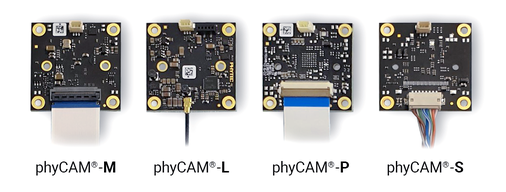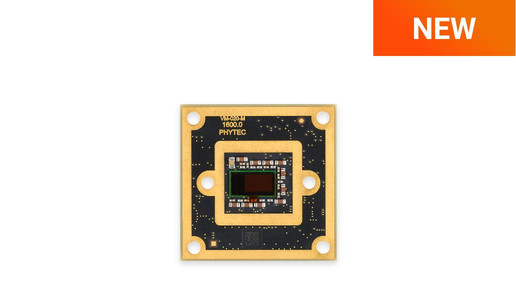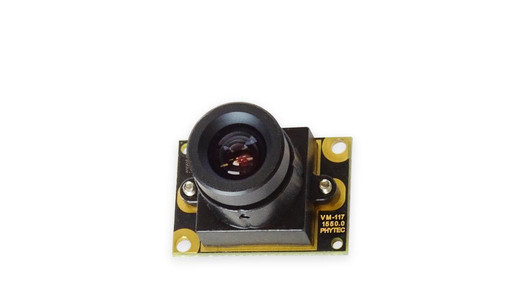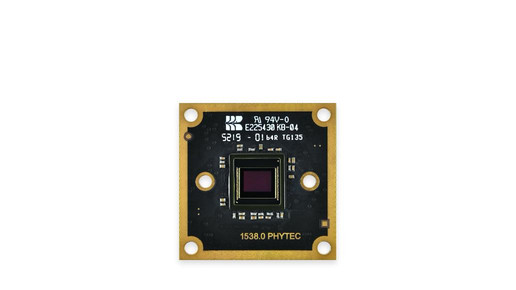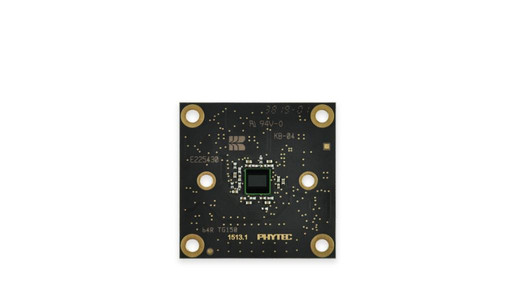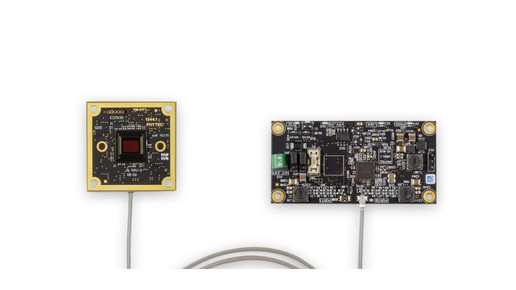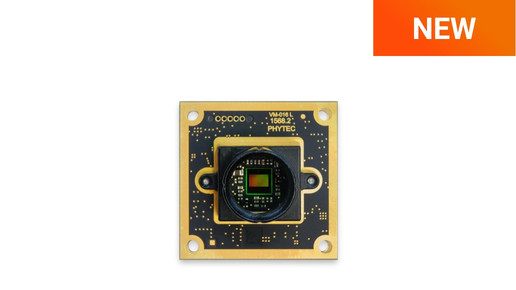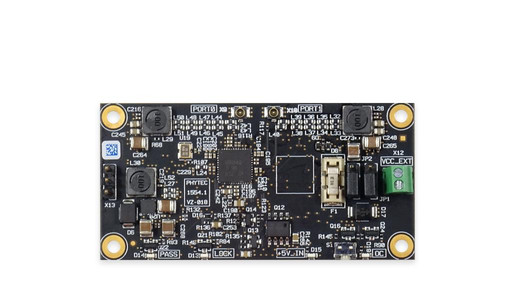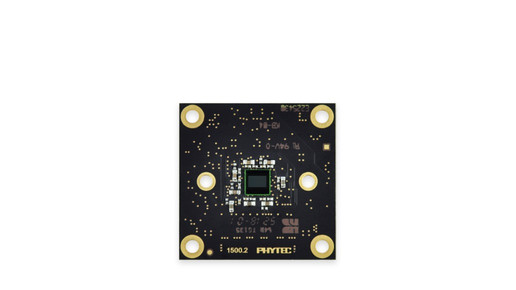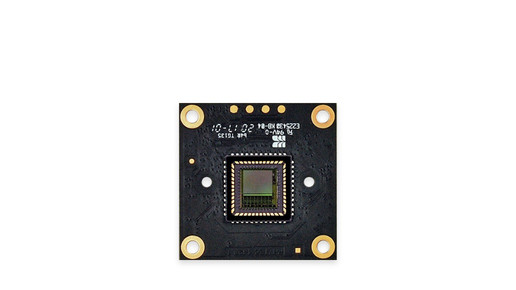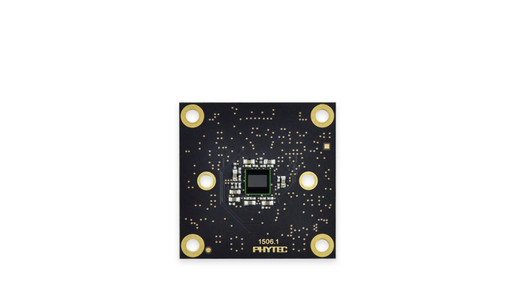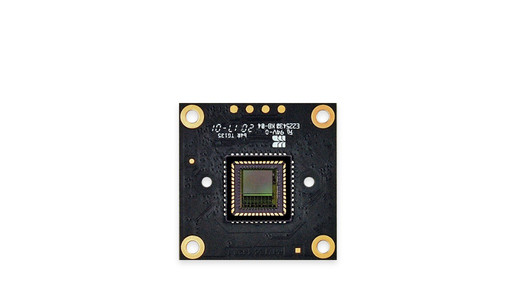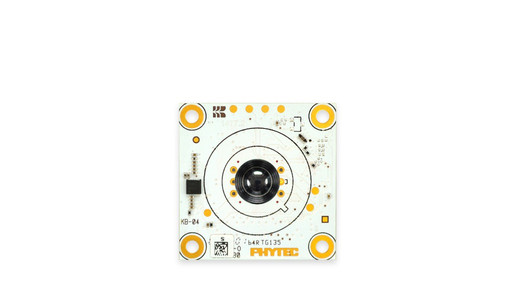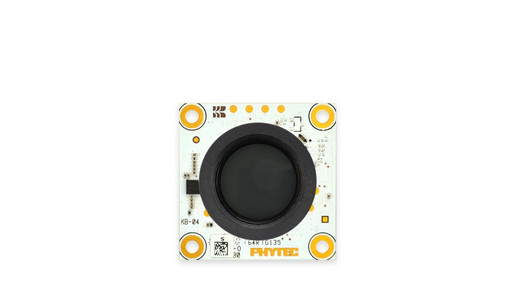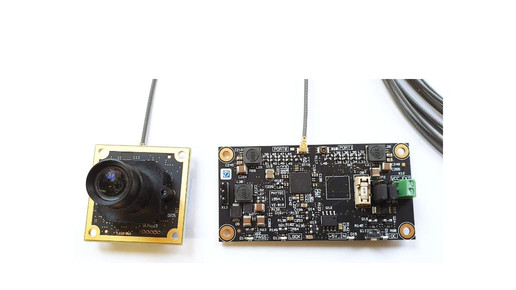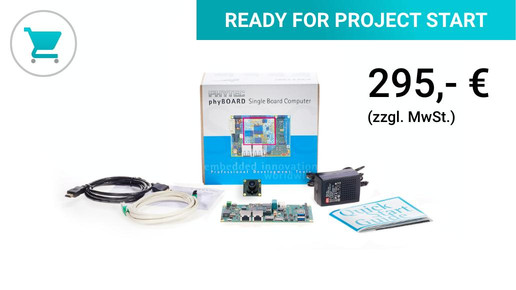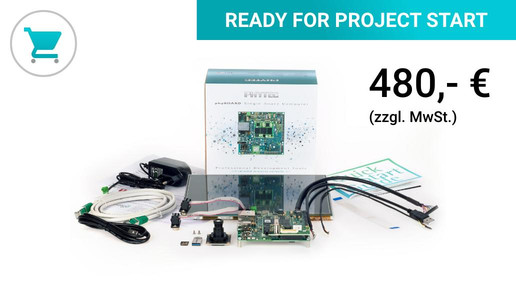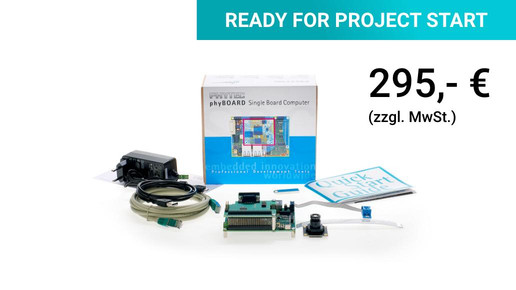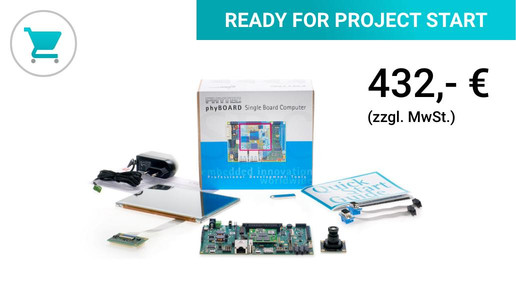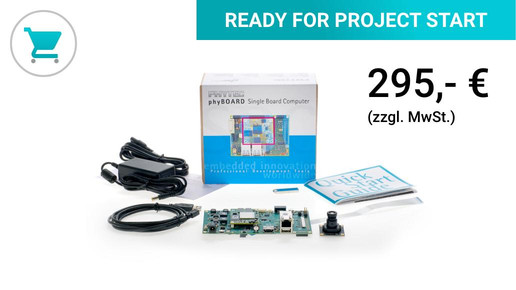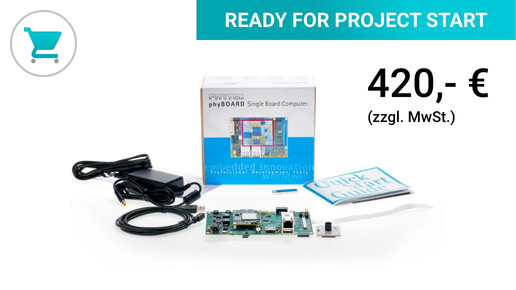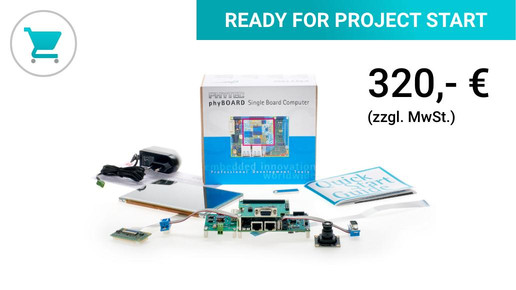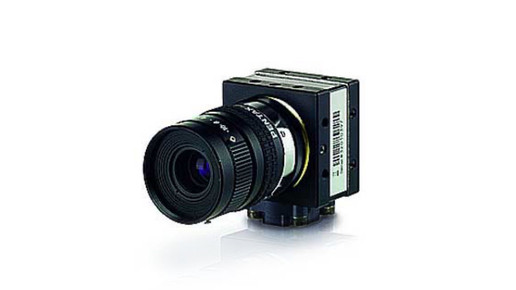Embedded vision is the key to the perfect integration of image processing in your serial device - efficient, cost-effective and optimized for high-volume production.
Powerful microcontrollers with an integrated camera interface make the implementation of camera sensors easier and cheaper. At PHYTEC, digital image processing is embedded in a wide range of microcontroller modules and development services.
phyCAM®-camera modules _ Systematic integrated image processing
The phyCAM®-Concept enables easy integration of camera sensors into embedded vision systems. The four interface systems phyCAMM, phyCAML, phyCAMP and phyCAM-S allow optimal adaptation to all circumstances. Thanks to the compatibility of the interfaces, the cameras can also be easily replaced on the hardware side - even during the design phase. All camera modules are standardized in terms of dimensions and have the same attachment points.
The phyCAM®-M-Interface is based on the MIPI CSI-2 standard and also defines a plug connector for professional applications. This means that different camera modules are compatible. The internal cable routing can be up to 15 cm and can be planned flexibly. The phyCAM®-M-Plug takes into account different supply voltages and additional control lines.
MIPI CSI-2 for industrial applications
The CSI‑2 standard from the MIPI Alliance is an interesting solution for connecting camera modules internally to the device. It enables high data throughput through multiple, bundled LVDS lanes. Originally from the consumer sector, it was used in industrial and professional applications Productsn difficult for two reasons: Firstly, camera sensors were practically only available for the consumer market. However, with the establishment of the CSI‑2 standard in the automotive sector, the first sensors are now coming onto the market that meet professional requirements - also with regard to long-term availability.
On the other hand, the CSI ‑ 2 standard does not contain a definition for the physical connector, so that modularity and interchangeability were not given. As a solution for this, PHYTEC has developed the phyCAM ‑ M interface. It takes into account industrial design criteria such as interchangeability and flexibility in cable routing. Thanks to the optionally switchable supply voltages of 3,3 V / 5 V, the interface is platform-open and can be easily adapted if necessary.
The phyCAM‑L Interface connects board-level cameras and MIPI CSI‑2 interfaces over a single coax cable up to 15 meters in length. The flexible coaxial cable is data channel and power supply at the same time. Another cable is not required. Subminiature connectors and single-board construction make phyCAM-L camera boards small and inexpensive. The system designer has new freedoms in camera placement and cable routing.
Two options are available for data transmission: Either the FPD‑Link III protocol developed by Texas Instruments for the automotive sector can be used, or V³Link, which is the cost-optimized version of the FPD-Link III interface. Both variants are compatible with each other and can also be used in combination if required.
At the receiver end, the signal is converted back to MIPI CSI-2 by a deserializer.
An expansion plug on the phyCAM-L camera modules enables the connection of additional hardware such as lighting or focus controls, which can be operated without additional cables.
The converter board VZ-018 is available for evaluation and small series.
The parallel phyCAM®-Variant offers a cost-effective way of integrating cameras. Data and control signals are transmitted in parallel via a 33-pin FFC cable. This minimizes the interface effort and still enables compatibility of the camera types.
The phyCAM®-S-Interface based on LVDS brings even more flexibility: The phyCAM®-S-Cable only needs eight wires and can be up to 5m long. This also enables the camera head and main unit to be separated.
phyCAM-M series
MIPI CSI-2 data interface
| Model | Image resolution (max.) | Sensor | Shutter | image sensor | optical format | Full size frame rate (max.) | Frame rate (std video) | trigger | Strobe | Lens connection without / M12 / C-CS" | EEPROM | dynamics | HDR"" |
|---|---|---|---|---|---|---|---|---|---|---|---|---|---|
| VM-020-CM | 2,3 megapixels (1920 x 1200) | Color | Global | AR0234 | 1 / 2.6 " | 120 fps | 134 fps (Full HD) | ✓ | ✓ | ✓ / ✓ / ✓ | ✓ | 71,4 dB | - |
| VM-020-MM | 2,3 megapixels (1920 x 1200) | Mono | Global | AR0234 | 1 / 2.6 " | 120 fps | 134 fps (Full HD) | ✓ | ✓ | ✓ / ✓ / ✓ | ✓ | 71,4 dB | - |
| VM-120-CM (Mini) | 2,3 megapixels (1920 x 1200) | Color | Global | AR0234 | 1 / 2.6 " | 120 fps | 134 fps (Full HD) | ✓ | ✓ | ✓ / ✓ / - | ✓ | 71,4 dB | - |
| VM-120-MM (Mini) | 2,3 megapixels (1920 x 1200) | Mono | Global | AR0234 | 1 / 2.6 " | 120 fps | 134 fps (Full HD) | ✓ | ✓ | ✓ / ✓ / - | ✓ | 71,4 dB | - |
| VM-017-COL-M | 5 MP (2592 x 1944) | Color | Rolling | AR0521 | 1 / 2.5 " | 60 fps | 120 fps (Full HD) | ✓ | ✓ | ✓ / ✓ / ✓ | ✓ | 40 dB | ✓ |
| VM-017-BW-M | 5 MP (2592 x 1944) | Mono | Rolling | AR0521 | 1 / 2.5 " | 60 fps | 120 fps (Full HD) | ✓ | ✓ | ✓ / ✓ / ✓ | ✓ | 40 dB | ✓ |
| VM-117-COL-M (Mini) | 5 MP (2592 x 1944) | Color | Rolling | AR0521 | 1 / 2.5 " | 60 fps | 120 fps (Full HD) | ✓ | ✓ | ✓ / ✓ / - | ✓ | 40 dB | ✓ |
| VM-117-BW-M (Mini) | 5 MP (2592 x 1944) | Mono | Rolling | AR0521 | 1 / 2.5 " | 60 fps | 120 fps (Full HD) | ✓ | ✓ | ✓ / ✓ / - | ✓ | 40 dB | ✓ |
| VM-016-COL-M | 1 MP (1280 x 800) | Color | Global | AR0144 | 1 / 4 " | 60 fps | 66 fps (HD) | ✓ | ✓ | ✓ / ✓ / ✓ | ✓ | 71,4 db | - |
| VM-016-BW-M | 1 MP (1280 x 800) | Mono | Global | AR0144 | 1 / 4 " | 60 fps | 66 fps (HD) | ✓ | ✓ | ✓ / ✓ / ✓ | ✓ | 71,4 db | - |
| VM-116-COL-M (Mini) | 1 MP (1280 x 800) | Color | Global | AR0144 | 1 / 4 " | 60 fps | 66 fps | ✓ | ✓ | ✓ / ✓ / - | ✓ | 71,4 db | - |
| VM-116-BW-M (Mini) | 1 MP (1280 x 800) | Mono | Global | AR0144 | 1 / 4 " | 60 fps | 66 fps | ✓ | ✓ | ✓ / ✓ / - | ✓ | 71,4 db | - |
phyCAM-L series
FPD-Link III data interface
| Model | Image resolution (max.) | Sensor | Shutter | image sensor | Optical Format | Full-Size Frame rate (max.) | frame rate (Std Video) | trigger | Strobe | Lens connection without / M12 / C-CS | EEPROM | dynamics | HDR |
|---|---|---|---|---|---|---|---|---|---|---|---|---|---|
| VM-020-CL | 2,3 megapixels (1920 x 1200) | Color | Global | AR0234 | 1 / 2.6 " | 120 fps | 134 fps (Full HD) | ✓ | ✓ | ✓ / ✓ / ✓ | ✓ | 71,4 dB | - |
| VM-020-ML | 2,3 megapixels (1920 x 1200) | Mono | Global | AR0234 | 1 / 2.6 " | 120 fps | 134 fps (Full HD) | ✓ | ✓ | ✓ / ✓ / ✓ | ✓ | 71,4 dB | - |
| VM-017-COL-L | 5 MP (2592 x 1944) | Color | Rolling | AR0521 | 1 / 2.5 " | 60 fps | 120 fps (Full HD) | ✓ | ✓ | ✓ / ✓ / ✓ | ✓ | 40 dB | - |
| VM-017-BW-L | 5 MP (2592 x 1944) | Mono | Rolling | AR0521 | 1 / 2.5 " | 60 fps | 120 fps (Full HD) | ✓ | ✓ | ✓ / ✓ / ✓ | ✓ | 40 dB | - |
| VM-016-COL-L | 1 MP (1280 x 800) | Color | Global | AR0144 | 1 / 4 " | 60 fps | 66 fps (HD) | ✓ | ✓ | ✓ / ✓ / ✓ | ✓ | 63.9 dB | - |
| VM-016-BW-L | 1 MP (1280 x 800) | Mono | Global | AR0144 | 1 / 4 " | 60 fps | 66 fps (HD) | ✓ | ✓ | ✓ / ✓ / ✓ | ✓ | 63.9 dB | - |
phyCAM-P series
parallel data interface
| Model | Image resolution (max.) | Sensor | Shutter | image sensor | Optical Format | Full-Size Frame rate (max.) | frame rate (Std Video) | trigger | Strobe | Lens connection without / M12 / C-CS | EEPROM | dynamics | HDR |
|---|---|---|---|---|---|---|---|---|---|---|---|---|---|
| VM-012-BW | 1,3 MP (1280 x 1024) | Mono | Global and rolling | Vita1300 | 1 / 2 " | 37 fps | 50 fps (Full HD) | ✓ | ✓ | ✓ / ✓ / ✓ | opt. | 60 dB | 90 dB |
| VM-016-COL-P | 1 MP (1280 x 800) | Color | Global | AR0144 | 1 / 4 " | 60 fps | 66 fps (Full HD) | ✓ | ✓ | ✓ / ✓ / ✓ | ✓ | 63,9 dB | - |
| VM-016-BW-P | 1 MP (1280 x 800) | Mono | Global | AR0144 | 1 / 4 " | 60 fps | 66 fps (Full HD) | ✓ | ✓ | ✓ / ✓ / ✓ | ✓ | 63,9 dB | - |
| VM-008 | PAL / NTSC (720x576) | Digitizer | - | - | - | 30 fps | 25 fps (PAL) | - | - | - | opt. | - | - |
phyCAM-S Series
LVDS data interface
| Model | Image resolution (max.) | Sensor | Shutter | image sensor | Optical Format | Full-Size Frame rate (max.) | frame rate (Std Video) | trigger | Strobe | Lens connection without / M12 / C-CS | EEPROM | dynamics | HDR |
|---|---|---|---|---|---|---|---|---|---|---|---|---|---|
| VM-012-BW-LVDS | 1,3 MP (1280 x 1024) | Mono | Global and rolling | Vita1300 | 1 / 2 " | 37 fps | 50 fps (Full HD) | ✓ | ✓ | ✓ / ✓ / ✓ | opt. | 60 dB | 90 dB |
| VM-016-COL-S | 1 MP (1280 x 800) | Color | Global | AR0144 | 1 / 4 " | 60 fps | 66 fps (Full HD) | ✓ | ✓ | ✓ / ✓ / ✓ | ✓ | 63,9 dB | - |
| VM-016-BW-S | 1 MP (1280 x 800) | Mono | Global | AR0144 | 1 / 4 " | 60 fps | 66 fps (Full HD) | ✓ | ✓ | ✓ / ✓ / ✓ | ✓ | 63,9 dB | - |
| VM-008 | PAL / NTSC (720x576) | Digitizer | - | - | - | 30 fps | 25 fps (PAL) | - | - | - | opt. | - | - |
Thermal imaging camera modules
parallel data interface (phyCAM-P)
| Model | Image resolution (max.) | Sensor | Object temperature | image sensor | temp Resolution | Calibration (Max.) | frame rate | trigger | Strobe | lens | Aperture | thermal pixels time constant | ISP |
|---|---|---|---|---|---|---|---|---|---|---|---|---|---|
| VM-050-021-0 | 32 x 32 | thermopile Array | -20 ...> 1000 ° C | HPTA32x32d | 0,3 K | +/- 2K + / - 2% | 8,9 fps | - | - | f = 2,1mm / 90 ° silicon | 0,8 | <4ms | ja |
| VM-050-050-0 | 32 x 32 | thermopile Array | -20 ...> 1000 ° C | HPTA32x32d | 0,3 K | +/- 2K + / - 2% | 8,9 fps | - | - | f = 5,0mm / 33 ° germanium | 0,85 | <4ms | ja |
| VM-051-048-0 | 80 x 64 | thermopile Array | -20 ...> 1000 ° C | HPTA80x64d | 0,3 K | +/- 2K + / - 2% | 8,9 fps | - | - | f = 4,8mm / 88x70 ° germanium | 0,8 | <4ms | ja |
| VM-051-105-0 | 80 x 64 | thermopile Array | -20 ...> 1000 ° C | HPTA80x64d | 0,3 K | +/- 2K + / - 2% | 8,9 fps | - | - | f = 10,0mm / 38x31 ° germanium | 0,95 | <4ms | ja |
Imaging Kits _ Development kits for embedded systems with digital cameras
All the necessary components of an embedded system with integrated image processing are put together in the kits, so that you can create your individual image processing solution quickly and effectively. Due to the flexibility of the standardized phyCAM-Sinterfaces, the camera properties can also be adjusted during the design phase depending on requirements. The required processor computing power can be scaled, for example, by scaling the number of processor cores in the NXP® i.MX6 or i.MX8 possible. The development kits can also be combined with other phyCAM cameras.

PHYTEC imaging kits contain the appropriate software drivers to address the camera boards from your own applications. Access to the camera driver under Embedded Linux done over V4L2. In order to test camera functions and to display a camera image, we provide demo applications that access the standard interface of the camera driver. This allows image data streams to be displayed and transmitted. Individual images or image sequences can be saved in various formats. On Linux these are scripts for GStreamer and an in C Created demo program, which is also contained as a source in all imaging kits. Middleware in the form of libraries are also included or can be installed. This includes image processing libraries such as OpenCV, Halcon Embedded or GStreamer.



USB cameras _ Ready-to-use camera heads with standard interfaces for the professional sector
The ultra-compact cameras of the USB-CAM series can be connected to any computer with a USB interface in just a few steps. The metal housing has fastenings on all four sides. Drivers for Windows10 contain. Under Linux the cameras can be controlled via the UVC interface speak to. The cameras can also be connected to PHYTEC microprocessor boards under Linux via V4L2 is possible.
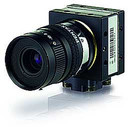
Equipment _ Lenses, cables, power supplies, tripods and spare parts for professional image processing systems

Visit our Online Showroom with trends and innovations almost as if you could touch them!
Take a quarter of an hour and take a look at our new products and technologies with one of our embedded experts - filmed live with two cameras and shown in person!
Other interesting topics:




